In this quick tutorial you'll learn how to draw a Red Grouper in 6 easy steps - great for kids and novice artists.
The images above represent how your finished drawing is going to look and the steps involved.
Below are the individual steps - you can click on each one for a High Resolution printable PDF version.
At the bottom you can read some interesting facts about the Red Grouper.
Make sure you also check out any of the hundreds of drawing tutorials grouped by category.
How to Draw a Red Grouper - Step-by-Step Tutorial
Step 1: The first step in drawing the red grouper is to draw the head with a closed mouth.
Step 2: Next, draw the gill, eye, and mouth. The gill is jagged and the mouth is a thin line. The eye is large with two dark circles.
Step 3: Then, draw the top of the body and start the patterning of the body.
Step 4: The next step is to draw the lower fins. There are two lower fins one that is round and the back one is more pointed.
Step 5: Next, draw the top fin, which is larger than the lower fins.
Step 6: The last step is to draw the tail.
Interesting Facts about the Red Grouper
Prized for its taste and size the Red Grouper has been a major part of commercial and recreation fisheries in the South Atlantic and Gulf of Mexico for years. They grow to impressive sizes, they’re long lived and slow to grow to maturity. Red Groupers are vulnerable to overfishing, they were declared overfished from 2000 to 2007. Red Groupers are important predators in reef food chains.
Did you know?
- Red Groupers start life as females but often transform into males at 7 to 15 years old.
- Red Groupers are opportunistic feeders that inhale their food instead of chewing it.
- Red Groupers excavate pits in the seafloor to attract prey items and other species.
- When aggravated or stressed Red Groupers can quickly change their color patterns.
- Adults occasionally move together in groups across short distances.
Lesson plan note: It’s difficult to balance the natural supply of Red Groupers and commercial demand for them. Place students in groups and have them come up with solutions to the problem of supply and demand. Then have each group debate how well each option would work.







